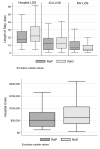Descriptive epidemiology of hospitalized patients with bacterial nosocomial pneumonia who experience 30-day readmission in the US, 2014-2019
- PMID: 36490261
- PMCID: PMC9733878
- DOI: 10.1371/journal.pone.0276192
Descriptive epidemiology of hospitalized patients with bacterial nosocomial pneumonia who experience 30-day readmission in the US, 2014-2019
Abstract
Introduction: Nosocomial pneumonia (NP) remains associated with excess morbidity and mortality. The effect of NP on measures such as re-admission at 30 days remains unclear. Moreover, differing types of NP may have varying impacts on re-admissions.
Methods: We conducted a multicenter retrospective cohort study within the Premier Research database, a source containing administrative, pharmacy, and microbiology data. We compared NP patients readmitted with pneumonia (RaP) as the principal diagnosis to those readmitted for other reasons (RaO) with respect to the type of NP (ventilator-associated bacterial pneumonia [VABP], ventilated hospital-acquired bacterial pneumonia [vHABP], and non-ventilated HABP [nvHABP]), and characteristics and outcomes of the index hospitalization.
Results: Among 17,819 patients with NP, 14,123 (79.3%) survived to discharge, of whom 2,151 (15.2%) required an acute readmission within 30 days of index discharge. Of these, 106 (4.9%) were RaP, and the remainder were RaO. At index hospitalization, RaP patients were older (mean age [SD] 67.4 (13.9] vs. 63.0 [15.2] years), more likely medical (44.3% vs. 36.7%), and less chronically ill (median [IQR] Charlson scores (3 [2-5] vs. 4 [2-5]) than persons with RaO. Bacteremia (10.4% vs. 17.5%), need for vasopressors (15.1% vs. 20.0%), dialysis (9.4% vs. 16.5%), and/or sepsis (9.4% vs. 16.5%) or septic shock 14.2% vs. 17.1%) occurred less frequently in the RaP group. With respect to NP type, nvHABP was most common in RaP (47.2%) and VABP in RaO (38.1%).
Conclusions: One in seven survivors of a hospitalization complicated by NP requires an acute rehospitalization within 30 days. However, few of these readmissions had a principal diagnosis of pneumonia, irrespective of NP type. Of the 5% of NP subjects with RaP, the plurality initially suffered from nvHABP.
Copyright: © 2022 Zilberberg et al. This is an open access article distributed under the terms of the Creative Commons Attribution License, which permits unrestricted use, distribution, and reproduction in any medium, provided the original author and source are credited.
Conflict of interest statement
I have read the journal’s policy. In addition to funding statement above, the following potential competing interest exist: •MDZ and AFS have received grant support and/or have served as consultants to Lungpacer, Melinta, Tetraphase, Pfizer, Astellas, Shionogi, The Medicines Company, Spero, and Theravance.
Figures



References
-
- Hospital Value Based Purchasing. Available at https://www.cms.gov/Medicare/Quality-Initiatives-Patient-Assessment-Inst...; accessed November 23, 2021.
Publication types
MeSH terms
LinkOut - more resources
Full Text Sources
Medical
Miscellaneous

